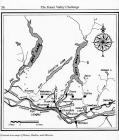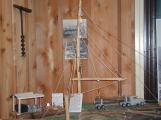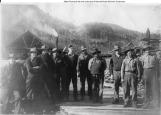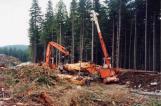5
The 1890sIn the early 1890's, a large communal-type settlement was established to the west of Mission along the Stave River by a group of people inspired by the prominent English Socialist John Ruskin.
Dressed lumber and railroad ties became one of the primary industries of this settlement and others in the area. Independent hand loggers, family-run logging operations and sawmills of varying capacity carried out logging there. In 1892/93 George Taggart constructed a sawmill at Silverdale. This mill produced both dressed lumber and railroad ties. Taggart's mill continued to operate until 1896. This was one of the first sawmills to specialize in making a particular product from Mission timber.
Timber for the mills was felled in the woods, the logs were then pulled out by oxen and horses to the edge of Stave River, to be put in the river for transporting. Once in the river, they floated down to the mills at the river mouth, on the Fraser River. Almost all the mills were near water, but only a few mills stayed in one place longer than five years. Once an area was completely logged, the company or family would move on to a new site.
Mission's first rail bridge (1891) was made of local timber products. This was also the first bridge across the lower Fraser and the first connection for the CPR through to Seattle in the United States.
8
The 1900sBy the early part of the century, logging had developed into a booming industry. Smaller operations still worked by hand, using oxen and horses, but the larger operators, who were able to afford the newer options were moving to steam power operations in conjunction with the railroads.
There were four major logging railroads that operated in the Mission and Haney areas. (see map) In the Mission area, Abernethy logging (the largest logging operation in the province, at the time) and Heaps Timber ran two main lines. There were a large number of small logging camps set up along each of these lines.
At about this time the invention of the Steam Donkey enabled logging companies to use steam power, rather than horses to skid (pull) logs from the woods to the railway. Steam Donkeys also allowed them to use steam power to load logs onto railcars. The Steam Donkey was a very welcome addition to the logging industry.
In 1908, Jimmy Michie and Richard Emanuel bought the property along the CPR tracks in Hatzic (on the east side of Mission) and built Mission's first fully steam powered mill.
11
The 1910sThe "Glory Days of Logging", were a mix of improved logging standards and the invention of some very useful techniques. By that time, almost every logging company had to have at least one steam donkey to survive. High lead systems for yarding were tested out and booms were brought in for loading the logs.
Abernethy Lougheed commenced an "A-Frame" logging operation at Stave Lake in 1915, after construction of the Stave Falls Dam. The Western Canada Power Company (WCPC) railway was used to shuttle Abernethy log cars between Stave Lake and the log dumps on the lower Stave River.
Around 1915, Keystone Logging set up operations and started logging east of Stave River. Their main rail line extended north of the river (map from the book "The Fraser Valley Challenge" courtesy of author Arnold McCombs). Much of the present day Keystone Avenue is located on the old rail bed.
Their operation used a new (for the time) development, the High Lead System and a McLean Boom for yarding and skidding. (see photo of high lead model, made by Moe Fossum) They had two locomotives and 22 log cars. With these improvements, they were able to take 30 or more carloads of logs a day to the mills.
12
Japanese logging workers Kanichi Tomita standing on leftApril, 1925
Forest camp, Mission, British Columbia
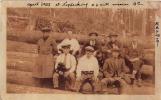
13
The 1920s and 1930sDuring the 1920s, the first logging trucks began to appear on the main streets of Mission. At the time Peter Bain still used a team of four horses to log (he became a major force as a lumber and railroad tie broker by the late 30's). Later on, Bain was the first man in Mission to use a hard rubber tired truck , while Pete Hammer was the first to use a pneumatic (air filled) tired truck.
Through the 1920s, more and more immigrants were coming to Canada, with hopes of starting a new and better life. Many Europeans (numerous Swedish, Finnish, and Norwegian) as well as the Chinese, East Indians, and Japanese found the town of Mission to be perfect. These men were hard workers and were often immediately hired to help at a logging site.
By the 1930s, almost all of Mission had been or was being logged and most of the small portable mills had disappeared from the Mission logging scene. Logging, with its accompanying sawmills and shake mills, had become Mission's most vital industry, with the Douglas fir going to the local tie mills and the red cedar going to the shingle mills.
An interesting part of Mission's logging history was recovered during research for this exhibit. Due to the relocations of WW2, many Japanese families left Mission and did not return. So, many links to the past have become vague or been lost. We learned that the Japanese were quite involved with the logging industry in the 1920s. Most people associate the early Japanese settlers with the berry industry in Mission, but at one time, there were 2 or 3 logging operations in the Hatzic Prairie area as well as more sawmills on Stave Lake that were owned by Ebbisuzaki and run by his relatives, the Tomitas. Ebbisuzaki's mill was destroyed by fire circa 1929-1931, after which he and his immediate family returned to Japan. The Tomita family stayed in Canada and ended up in Webster's Corners (Maple Ridge) then Delta (closer to Vancouver), they have returned periodically to visit Mission. Their latest visit to Mission was in 2002, when they very kindly shared their photographs with the museum, at the time of initial research for this project.
15
The 1940s and 1950sSince the mid 1930's it has been more efficient to bring logs and shake and shingle bolts to mills on the Fraser River with transportation being either by truck or water.
Saw milling (for dimensional, or dressed, lumber) has all but disappeared from Mission. Shake and shingle manufacturing is now the dominant lumber industry in this area.
During the 1940's there were a few new mills started in the Mission area and new names became associated with the lumber industry in Mission. (Watkins, McMahon, Thomas, Braich) Many of their mills are still in local operation. One of the main lumber mill operations started was the Thomas Lumber Company, opened in 1945 by Albert Thomas (because Albert's father was a photographer we have many photos from this family). McMahon Lumber Company opened in 1947. Bill Watkins opened a mill outside of Mission in 1942 and moved it to Mission in 1959.
Shirley Ruddick, a woman of many talents, from cooking camp meals to operating skidders and who helped put this exhibit together was introduced to camp life at a young age. Her husband Bruce Ruddick worked at Stave Lake, for his brother Ken Ruddick (Flo Lake Logging Co.), and for Bob Cameron. Between 1948 and 1952, Bruce joined forces with Ken and they operated under the name of Ruddick Brothers. In 1953, the business name was changed to K&B Logging.
Their business kept a camp at Stave Lake, where the woodsmen would stay out during the workweek. (See videos in this exhibit) Shirley and her children also lived up at camp. She related how, on Monday mornings they would all pile into the Kingfisher boat that would take them up the Stave River and across the Stave Lake to their camp. On a good day, the boat trip would take about one hour. There were usually about 9 men going to work with the family.
Upon arrival, the men would unload everything and Shirley would take her kids to the cookhouse on top of the hill to start making coffee and packing lunches. The camp was on the hillside, and the cookhouse (photo) was actually on a slant, with holes in the floor. This was to let the water drain out after hosing it down for cleaning. From the vantage point of the cookhouse, she could see any visitors that came to the camp. "Visitors" consisted of the Workmen's Compensation Board representative, the forestry people, and the odd fisherman.
Coming home on Fridays meant another boat trip, and sometimes boats would race each other down the lake.
16
K. and B. cookhouse, camp buildings and bunkhouses located at the top of a hill.1950
K. and B. Logging camp on Stave Lake

17
The 1960s-1970sBy the 1970s, logging was a more serious business. You could no longer claim a piece of land, log it and move on to a new area. The government had created rules and regulations governing the logging industry.
Locally, Peter Kokoska was awarded the first licensed Woodlot in BC, number WL0001. Originally (in 1940), Adam Kokoska (Peter's father) had owned a BC Farm lot license that allowed him to log and replant 160 acres. In 1979, the government changed the outline and said that woodlots could be 1000 acres, but farmlots couldn't change from 160 acres.

